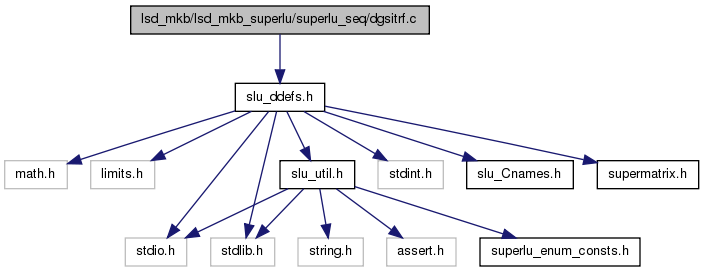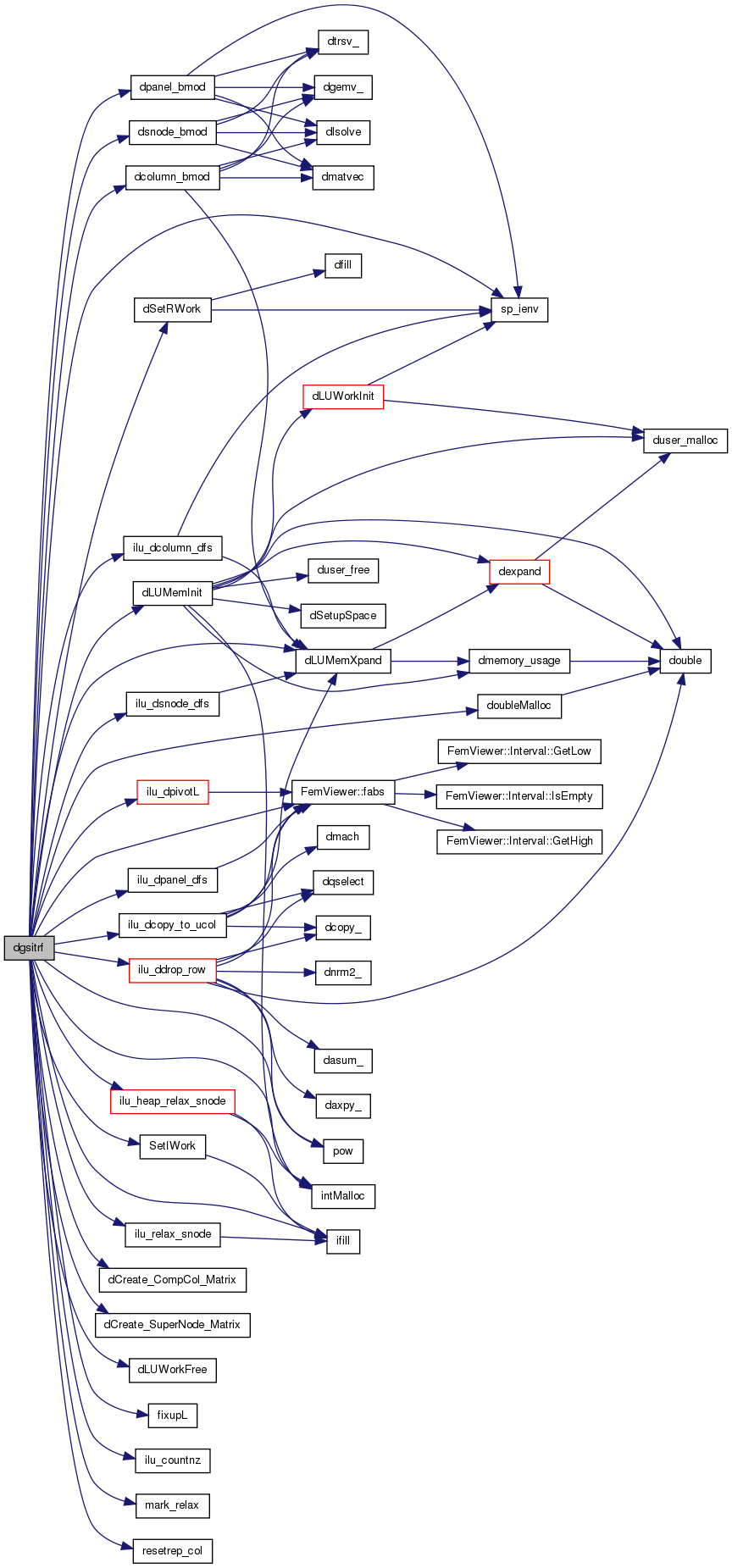Purpose
=======
DGSITRF computes an ILU factorization of a general sparse m-by-n
matrix A using partial pivoting with row interchanges.
The factorization has the form
Pr * A = L * U
where Pr is a row permutation matrix, L is lower triangular with unit
diagonal elements (lower trapezoidal if A->nrow > A->ncol), and U is upper
triangular (upper trapezoidal if A->nrow < A->ncol). See supermatrix.h for the definition of 'SuperMatrix' structure.
Arguments
=========
options (input) superlu_options_t*
The structure defines the input parameters to control
how the ILU decomposition will be performed.
A (input) SuperMatrix*
Original matrix A, permuted by columns, of dimension
(A->nrow, A->ncol). The type of A can be:
Stype = SLU_NCP; Dtype = SLU_D; Mtype = SLU_GE.
relax (input) int
To control degree of relaxing supernodes. If the number
of nodes (columns) in a subtree of the elimination tree is less
than relax, this subtree is considered as one supernode,
regardless of the row structures of those columns.
panel_size (input) int
A panel consists of at most panel_size consecutive columns.
etree (input) int*, dimension (A->ncol)
Elimination tree of A'*A.
Note: etree is a vector of parent pointers for a forest whose
vertices are the integers 0 to A->ncol-1; etree[root]==A->ncol.
On input, the columns of A should be permuted so that the
etree is in a certain postorder.
work (input/output) void*, size (lwork) (in bytes)
User-supplied work space and space for the output data structures.
Not referenced if lwork = 0;
lwork (input) int
Specifies the size of work array in bytes.
= 0: allocate space internally by system malloc;
> 0: use user-supplied work array of length lwork in bytes,
returns error if space runs out.
= -1: the routine guesses the amount of space needed without
performing the factorization, and returns it in
*info; no other side effects.
perm_c (input) int*, dimension (A->ncol)
Column permutation vector, which defines the
permutation matrix Pc; perm_c[i] = j means column i of A is
in position j in A*Pc.
When searching for diagonal, perm_c[*] is applied to the
row subscripts of A, so that diagonal threshold pivoting
can find the diagonal of A, rather than that of A*Pc.
perm_r (input/output) int*, dimension (A->nrow)
Row permutation vector which defines the permutation matrix Pr,
perm_r[i] = j means row i of A is in position j in Pr*A.
If options->Fact = SamePattern_SameRowPerm, the pivoting routine
will try to use the input perm_r, unless a certain threshold
criterion is violated. In that case, perm_r is overwritten by
a new permutation determined by partial pivoting or diagonal
threshold pivoting.
Otherwise, perm_r is output argument;
L (output) SuperMatrix*
The factor L from the factorization Pr*A=L*U; use compressed row
subscripts storage for supernodes, i.e., L has type:
Stype = SLU_SC, Dtype = SLU_D, Mtype = SLU_TRLU.
U (output) SuperMatrix*
The factor U from the factorization Pr*A*Pc=L*U. Use column-wise
storage scheme, i.e., U has types: Stype = SLU_NC,
Dtype = SLU_D, Mtype = SLU_TRU.
Glu (input/output) GlobalLU_t *
If options->Fact == SamePattern_SameRowPerm, it is an input;
The matrix A will be factorized assuming that a
factorization of a matrix with the same sparsity pattern
and similar numerical values was performed prior to this one.
Therefore, this factorization will reuse both row and column
scaling factors R and C, both row and column permutation
vectors perm_r and perm_c, and the L & U data structures
set up from the previous factorization.
Otherwise, it is an output. stat (output) SuperLUStat_t*
Record the statistics on runtime and floating-point operation count.
See slu_util.h for the definition of 'SuperLUStat_t'.
info (output) int*
= 0: successful exit
< 0: if info = -i, the i-th argument had an illegal value
> 0: if info = i, and i is
<= A->ncol: number of zero pivots. They are replaced by small
entries according to options->ILU_FillTol.
> A->ncol: number of bytes allocated when memory allocation
failure occurred, plus A->ncol. If lwork = -1, it is
the estimated amount of space needed, plus A->ncol.
======================================================================
Local Working Arrays:
======================
m = number of rows in the matrix
n = number of columns in the matrix
marker[0:3*m-1]: marker[i] = j means that node i has been
reached when working on column j.
Storage: relative to original row subscripts
NOTE: There are 4 of them:
marker/marker1 are used for panel dfs, see (ilu_)dpanel_dfs.c;
marker2 is used for inner-factorization, see (ilu)_dcolumn_dfs.c;
marker_relax(has its own space) is used for relaxed supernodes.
parent[0:m-1]: parent vector used during dfs
Storage: relative to new row subscripts
xplore[0:m-1]: xplore[i] gives the location of the next (dfs)
unexplored neighbor of i in lsub[*]
segrep[0:nseg-1]: contains the list of supernodal representatives
in topological order of the dfs. A supernode representative is the
last column of a supernode.
The maximum size of segrep[] is n.
repfnz[0:W*m-1]: for a nonzero segment U[*,j] that ends at a
supernodal representative r, repfnz[r] is the location of the first
nonzero in this segment. It is also used during the dfs: repfnz[r]>0
indicates the supernode r has been explored.
NOTE: There are W of them, each used for one column of a panel.
panel_lsub[0:W*m-1]: temporary for the nonzeros row indices below
the panel diagonal. These are filled in during dpanel_dfs(), and are
used later in the inner LU factorization within the panel.
panel_lsub[]/dense[] pair forms the SPA data structure.
NOTE: There are W of them.
dense[0:W*m-1]: sparse accumulating (SPA) vector for intermediate values;
NOTE: there are W of them.
tempv[0:*]: real temporary used for dense numeric kernels;
The size of this array is defined by NUM_TEMPV() in slu_util.h.
It is also used by the dropping routine ilu_ddrop_row().



 1.6.1
1.6.1